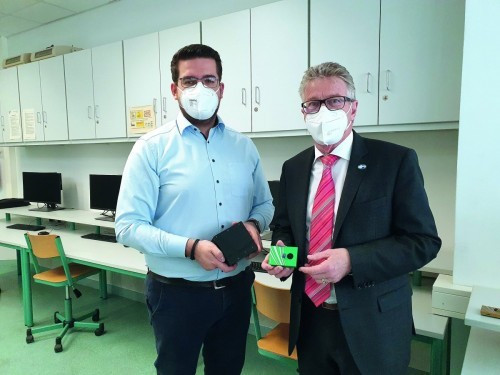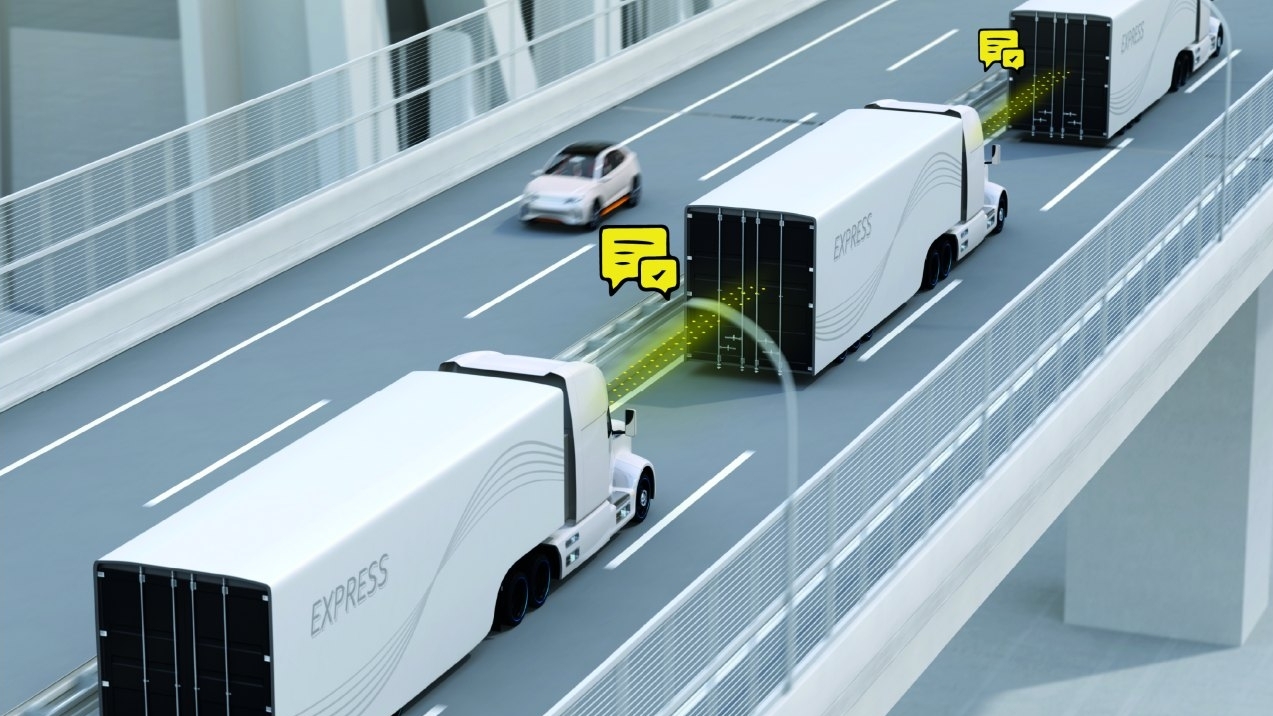LiFi (light fidelity), wireless data transmission using light or infrared signals, has been a well-known topic in research for some time. So far, however, LiFi networks have only been used in pilot projects. According to the Fraunhofer Heinrich Herz Institute Berlin (HHI), which is helping to develop optical data transmission, it will still be some time before LiFi reaches mass application. However, it is worth taking a look at two projects that have been successfully launched in recent months.
LiFi (light fidelity), wireless data transmission using light or infrared signals, has been a well-known topic in research for some time. So far, however, LiFi networks have only been used in pilot projects. According to the Fraunhofer Heinrich Herz Institute Berlin (HHI), which is playing a key role in developing optical data transmission, it will be some time before LiFi reaches mass application. But it is worth taking a look at two projects that have been successfully launched in recent months.
For example, the Japanese service provider for mobile communication infrastructure Sangikyo Corporation has used Fraunhofer HHI's LiFi technology for the first time in a pilot project to network driverless trucks. During the trial on the Tomei Highway near Shizuoka at the end of February 2021, the continuous communication of the LiFi modules attached to the front and rear bumpers made it possible to connect three trucks for autonomous convoy driving, a so-called platoon. The vehicles drive a short distance behind each other, which saves fuel and driving personnel and increases safety on highways.
In platooning, accelerator, brake and steering interventions are carried out synchronously using vehicle-to-vehicle (V2V) communication. The communication required for platooning can take place via a variety of channels. So far, it has only been tested on the basis of 5G or WLAN-based data transmission technologies. Sangikyo Corporation's trial project is the first of its kind to rely on optical communication as the primary source of communication between the trucks for data transmission.
LiFi platooning on the highway
 Dr. Dominic Schulz (Fraunhofer HHI) and Winfried Ottmann, Head of Education in the Main-Kinzig district, make the case for LiFi in the classroomForthe demonstration, the Sangikyo team attached LiFi transceivers to the front and rear bumpers of the trucks, which can send, receive and process information. During the journey, only the truck in front was controlled by a driver, while the two trucks behind followed autonomously based on the data sent by the first truck. To ensure the safety of the test, the autonomous vehicles were only manned by safety personnel in the passenger seats. A constant distance of around nine meters was maintained at a speed of 80 km/h.
Dr. Dominic Schulz (Fraunhofer HHI) and Winfried Ottmann, Head of Education in the Main-Kinzig district, make the case for LiFi in the classroomForthe demonstration, the Sangikyo team attached LiFi transceivers to the front and rear bumpers of the trucks, which can send, receive and process information. During the journey, only the truck in front was controlled by a driver, while the two trucks behind followed autonomously based on the data sent by the first truck. To ensure the safety of the test, the autonomous vehicles were only manned by safety personnel in the passenger seats. A constant distance of around nine meters was maintained at a speed of 80 km/h.
Platooning offers the following advantages: Automated slipstreaming in the convoy significantly reduces fuel consumption and also increases safety on highways. Sr. Shogo Hayashida, Manager of Sangikyo Corporation, is convinced by the platooning project: "With our demonstration, we were able to successfully show the potential of the new LED-based optical wireless communication."
The team from the 'Photonic Networks and Systems' department at Fraunhofer HHI supported Sangikyo in using and testing the LiFi technology. For Dr. Dominic Schulz, project manager at Fraunhofer HHI, the test results prove "the importance of LiFi technology as a pioneer for safe autonomous driving, smart cities and ultimately the increasingly networked society." In addition to the current demonstration, the Fraunhofer HHI is also investigating optical truck-to-truck communication in cooperation with the car manufacturer Ford in the EU-funded research project 'Vision' (Visible light based Interoperability and Networking).
The first LiFi classroom is being tested in Hesse
Another pilot project aims to enable wireless data transmission via light in classrooms, the digitalization of which has been the subject of heated debate during the SARS-Cov-2 pandemic. The Fraunhofer HHI equipped the classroom of a vocational school in Gelnhausen (Main-Kinzig district) with the new LiFi technology. The installation and test phase, which lasted several months, was completed in spring 2021. Researchers at Fraunhofer HHI then put the LiFi installation into operation. Germany's first networked LiFi classroom was thus created.
What is LiFi
Light fidelity networks, LiFi for short, transmit data using light and are therefore many times faster than electromagnetic Wi-Fi systems. Stable transmission rates of 10 Gbit/s and more can be achieved in a LiFi network. LiFi requires that there is a line of sight between the transmitter and receiver without any obstacles. While electromagnetic waves can penetrate walls and a Wi-Fi hotspot can easily cover several rooms, this is not easily possible with LiFi. If you want to use optical data transmission in the office, for example, every room must be equipped with the technology so that a user does not permanently lose the connection when working with a mobile device (e.g. a tablet or smartphone). However, this limitation of LiFi is also its security advantage. WiFi networks offer points of attack for external hackers - with LiFi, a system can only be accessed if you are in a room with the LiFi hotspot within a range of a few meters.
According to the Fraunhofer Institute for Photonic Microsystems (IMPS), LiFi could also soon find its way into replaceable circuit boards. Up to now, circuit boards have been connected to each other via high-frequency cables and mechanically fragile connectors - this limits their service life when they need to be replaced and reconnected. A wireless solution is LiFi modules that can be soldered directly onto the boards.
LiFi networks are also of particular interest to the production and manufacturing industry. Critical infrastructures can be securely networked with LiFi - the limited radius of action offers an enormous security advantage as it prevents interference from outside. In addition, the data connection via light waves only needs to be maintained for as long as it is required on an ad hoc basis. Once the information has been transmitted, the signal disappears immediately.
LiFi technology can be used as an alternative or supplement to the widely used WLAN. LiFi uses the optical spectrum to transmit data at high speeds. The frequency of the generated light pulses is so high that the human eye cannot perceive the flickering of the light. Classic wireless networks are relieved by LiFi. At the same time, protection against unauthorized access is ensured, as communication is only possible in a spatially limited area illuminated by LiFi.
Some of the communication cells in the LiFi system are equipped with several optical front ends and are networked with each other in this way. This ensures uninterrupted communication. Laptops and other end devices with connected USB LiFi modules can therefore be used on the move in the classroom. The system achieves connection speeds of up to 500 Mbit/s.
The first networked LiFi classroom in Germany is now being intensively tested by teachers and pupils in order to gather important user experience so that the system can be further improved. In the coming months, the researchers and the school will exchange experiences and gather further ideas for integrating the LiFi system into everyday school life.
With the pilot project, the Main-Kinzig district wants to take on a pioneering role in the evaluation of LiFi, convince itself of the practical advantages compared to conventional wireless solutions and play an active role in the digitalization of schools by allowing pupils to test the future-oriented system. Other vocational schools have also already expressed an interest in LiFi networks.
References and sources:
Fraunhofer HHI, www.hhi.fraunhofer.de/abteilungen/pn/forschungsgruppen/optische-metro-zugangs-und-inhausnetze/light-communication-was-ist-lifi.html
Li-Fi: Network with light and flocks, https://www.t-systems.com/de/blickwinkel/netze/light-fidelity/li-fi-659328


